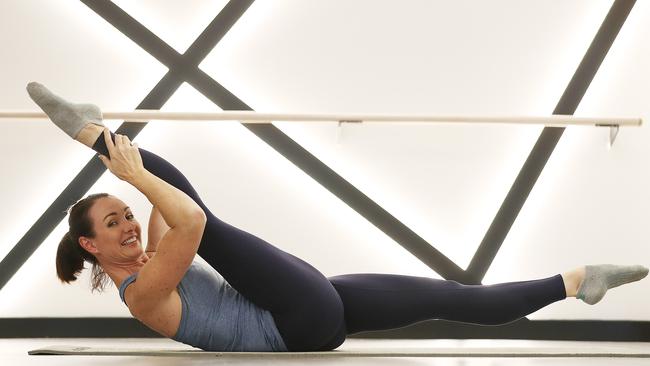How to be flexible after 40
Ageing won’t give anyone a free pass but stretching and drinking plenty of water will help you stay ahead of the curve.

When was the last time you came remotely close to touching your toes? You may want to try a bit harder. Flexibility declines sharply with age and the effects of this loss can be profound — as we move less freely, the risk of injury rises and our posture deteriorates.
“Ageing takes its toll on our flexibility in a big way,” says Dalton Wong, director of Twenty Two Training.
“Once we hit 40, the body’s connective tissue — skin, tendons and ligaments — becomes less elastic and more prone to snapping.”
A 2013 study from the University of Western Ontario shows the average drop in flexibility of hip and shoulder joints means they can move about six degrees less in any direction each decade from a person’s mid-50s.
“Lack of flexibility affects posture and the way we move, which can then affect breathing and digestion,” Wong says.
Stretching instructor Suzanne Wylde says the longer you ignore flexibility, the worse things get. “When we are tight it puts more wear and tear on our joints,” she says. “And declining flexibility is compounded by inactivity because, as we move less, we develop more tightness and restriction — causing more aches and pains.”
Studies have shown that a lack of flexibility can be a red flag for serious health problems. A study in the AJP Heart and Circulatory Physiology Journal (2009) revealed that a lack of flexibility in the trunk, hamstrings and lower back might indicate how stiff your arteries were — and thicker, stiffened artery walls could lead to high blood pressure.
“By improving flexibility, you will look and feel leaner, healthier and lighter,” Wylde says. “Your posture improves and you will move and breathe better.”
Here’s how to become more supple as you age:
Stretch a little every day
Do some stretching for at least 10 minutes each day. Incorporate stretches of all the main muscles in the legs, back, shoulders and arms, as well as the trunk; simple movements such as arm swings and bends.
“General stretching at home is fine, but also try activities that involve active stretching such as Pilates, tai chi and other martial arts or callisthenics classes,” Wong says.
“And combine this with regular massage if you can, as it will help you to achieve deeper stretches.”
Release your fascia
It’s not just stretching muscles, you also need to release tension from the fascia — the dense, fibrous, connective tissue that encompasses all muscles and bones.
“In small amounts, fascial tissue is protective, but it can accumulate through intense exercise or injuries and become restrictive, limiting our ability to move freely,” Wylde says.
In January a study in the Journal of Anatomy reported that “age-related changes in fascia thickness may be a contributing factor of restrictions in joint range of motion”.
Resistance stretching classes that aim to provide myofascial release (“myo” referring to muscle and “fascia” being the connective tissue) are something of a gym trend, and involve intense and powerful super-stretches.
“It helps to recondition the fascia, keeping it youthful and supple,” Wylde says.
Hate yoga? Try dance
Classical ballet dancers perform up to 50 different stretching exercises every day, each designed to target specific muscles, and many are included in workouts such as the NYCB (New York City Ballet) gym classes and workout video. Any barre class or dance will improve flexibility, and some studios such as XTend Barre run classes dedicated to dance stretching.
Last year a three-month trial at the Queensland University of Technology found that older adults who took part in ballet-style classes experienced greater flexibility and improved posture after 10 sessions.
How to use a foam roller
“We don’t really know precisely how a foam roller works, but it seems to target the fascia that surround muscle, resulting in better feedback between muscle and brain,” says Lewis MacGregor, a lecturer in physiology and sport nutrition at the University of Stirling.
“It can be a useful tool as part of a warm-up, used in combination with stretching.”
However, the effects of improved flexibility are short-lived. “There’s some evidence of a cumulative effect if you roll every day providing benefits that last two weeks, but if flexibility is your aim you should roll and repeat at least twice a day.”
Drink more water
The healthier your connective tissue, the more responsive your body will be to stretching and flexibility work. And cartilage, tendons and ligaments that are well hydrated are likelier to stay refreshed and elastic.
“Dehydrated tissue ultimately means tighter fascia and muscles,” Wylde says. “Drinking water regularly will help to keep your connective tissues healthier over time, and stretching will also enhance hydration of the tissues.”
Lift weights
It sounds counterintuitive, but Wong says weight training is an excellent way to build on flexibility. “The older you get, the less lean muscle mass you have, and that translates into more of a stooped posture,” he says.
“As your posture worsens, your muscles shorten and your flexibility takes even more of a nosedive.” Lifting weights preserves muscle mass but also “forces your body into a range of movement you wouldn’t otherwise achieve”, Wong says.
Switch your yoga class
Everyone thinks of yoga as the optimal route to bendiness. “Where it generally falls down is in its inability to release fascia,” Wylde says. “Although yoga is a useful route to better mobility.” There are some forms that do target fascial release as well as muscle flexibility. Best of all is yin yoga, which involves slow-paced moves, such as forward bends and low lunges, that are held for about two minutes (and sometimes up to five).
The Times



To join the conversation, please log in. Don't have an account? Register
Join the conversation, you are commenting as Logout